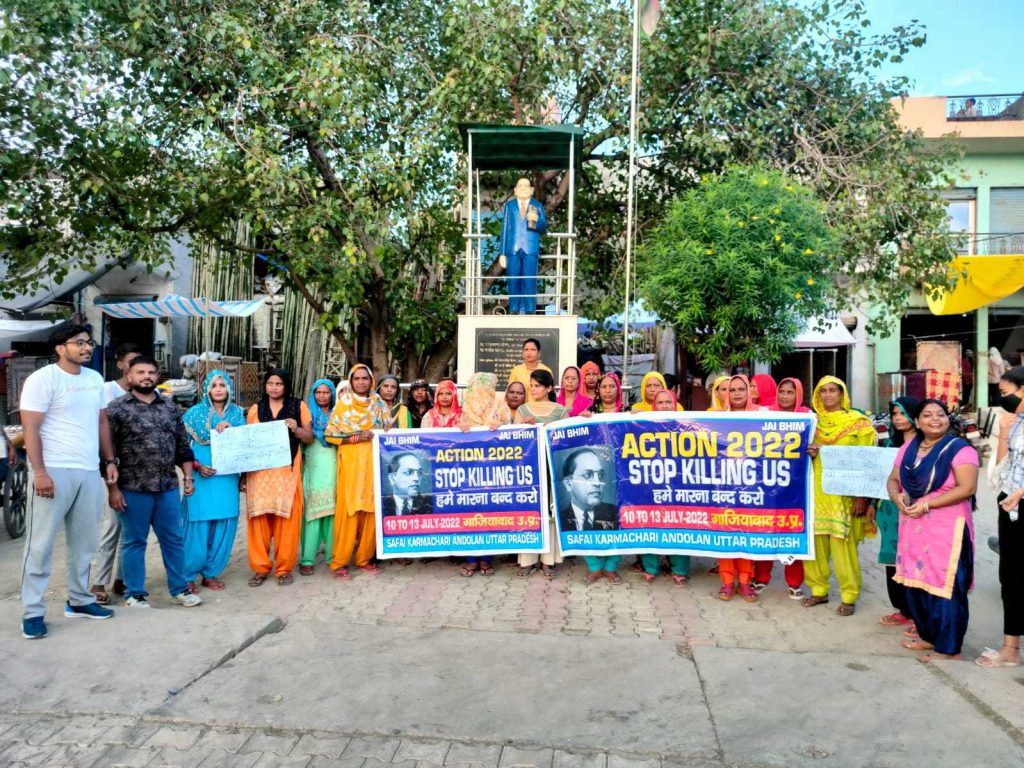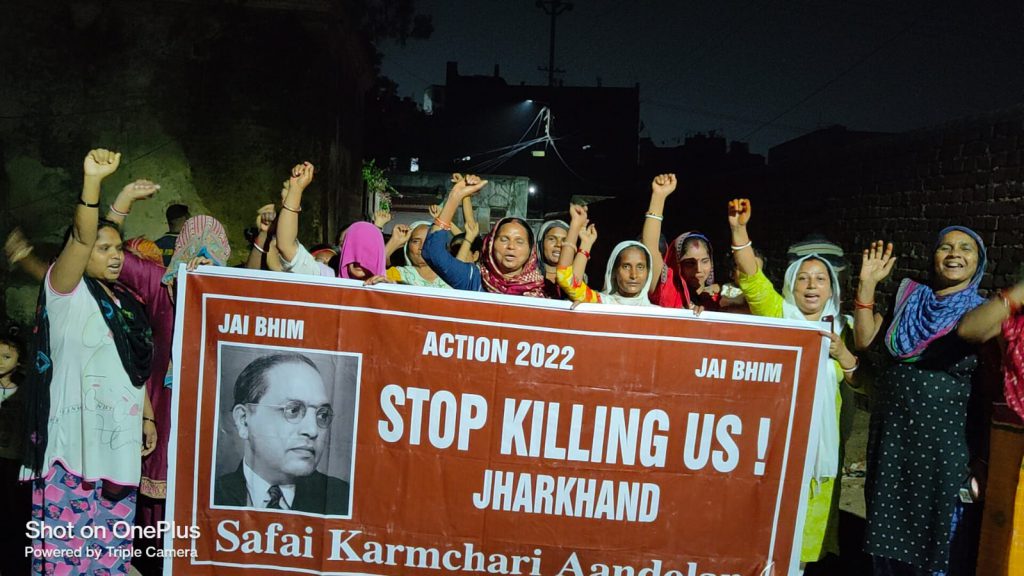The unending fight against manual scavenging

The Manual Scavenging Act, 2013 prohibits employing a person as manual scavenger to clean insanitary latrines. Yet, this unconstitutional practice continues under the garb of ‘traditional occupation,’ which has its roots in the discriminatory caste system.
The birth of Safai Karmachari Andolan
Bezwada Wilson was born in 1966 in Karnataka in a ‘scavenger family.’ He mentions his early experiences of caste as the reason for his decision to work towards the elimination of the age-old practice of manual scavenging.
The Employment of Manual Scavengers and Construction of Dry Latrines Act, enacted by the Indian parliament in 1993, had little to no impact on the practice of manual scavenging. Wilson, along with volunteers, took the matters into his own hands: he photographed and documented manual scavengers and dry latrines until they were acknowledged by the Karnataka government in 1994. Later, he moved to Andhra Pradesh where he continued to work towards liberating and rehabilitating manual scavengers. In the same year, he founded the Safai Karmachari Andolan.
Wilson’s campaign has primarily two goals: first, to raise awareness amongst the manual scavengers that they are not bound to such lowly tasks; and second, to help them in finding alternative solutions.
In December 2003, Safai Karmchari Andolan, along with some other organisations, filed a writ petition in the Supreme Court under Article 32 of the Constitution. They asked to ensure the eradication of dry latrines and recognition of the dehumanising practice of manual scavenging as a violation of the fundamental rights guaranteed by the Constitution.
Wilson was awarded the Ramon Magsaysay award in 2016 in recognition of his activism and contribution toward the upliftment of marginalised communities.
The Prohibition of Employment as Manual Scavengers and Their Rehabilitation Act, 2013
The Prohibition of Employment as Manual Scavengers and Their Rehabilitation Act, 2013 expressly acknowledges “Article 17 and Article 21 rights of the persons engaged in sewage cleaning and cleaning tanks as well persons cleaning human excreta on railway tracks.” It contains several forms of entitlements and benefits for the rehabilitation of manual scavengers. The act also helps rehabilitate the children of identified manual scavengers by providing “scholarship as per the relevant scheme of the Central Government or the State Government or the local authorities, as the case may be.” The act also states that the instance of manual scavengers “entering sewer lines without safety gears should be made a crime even in emergency situations. For each such death, compensation of Rs. 10 lakhs should be given to the family of the deceased.”
Despite these provisions, barely half of the identified manual scavengers received these benefits. The Wire reported that between 1993 and 2019, only 50% of the victims’ families had been compensated, many receiving less than Rs 10 lakh.

Loopholes in the Law and Data Inaccuracy
According to Statista, 920 manual scavenger deaths were recorded during the period from 1993 to 2010 due to manual cleaning of sewers and septic tanks. Despite being outlawed in 2013, this practice continues and as of December 31, 2020, a total of 340 deaths had been reported by the government in the previous five years alone. This data, however, was collected from a survey which was limited to 20 states and union territories.
Another survey conducted in 2018 by the National Safai Karmachari Finance and Development Corporation, under the directive of the Ministry of Social Justice and Empowerment, identified around 44,000 manual scavengers. This figure too is an undercount as the survey was conducted only in 14 states. However, surveys conducted by some petitioner organisations estimated over 12,00,000 manual scavengers in the country. There is an apparent inaccuracy in data collection resulting in an underreporting of the numbers of manual scavengers and deaths recorded.
Data inaccuracy is not the only reason why there has been an underreporting in the numbers. Previous deaths that occurred due to manual scavenging and those that occurred while cleaning the sewers had been reported as two different categories by the government. The reason why not a single case of manual scavenger death has led to a conviction is due to the lacuna present in the 2013 Act itself. The act prohibits a person from hazardous cleaning “without the employer fulfilling his obligations to provide protective gear and other cleaning devices and ensuring observance of safety precautions” (section 2(d)) but simultaneously states that “a person engaged or employed to clean excreta with the help of such devices and using such protective gear, as the Central Government may notify in this behalf, shall not be deemed to be a ‘manual scavenger’” (section 2 (g-b). The law fails to define such “protective gear,” which leaves loopholes resulting in misinterpretation and poor implementation of the laws.
Caste and Health
Due to the high number of septic tanks, single-pit toilets, and low availability of suction pumps, especially in rural areas, mechanical extraction is not possible and most of the cleaning is done manually. Workers enter septic tanks and sewers to clean them without safety gear. These tanks are designed in such a manner that it is only possible for a human to enter to clear any clogging or choke-ups.
According to government data, more than 97% of manual scavengers belong to Scheduled Castes and they have been engaged in this dangerous work for generations. Most often they are the solitary earners of their families. The stigma attached to their caste identity and occupation, keeps them away from having a basic standard of living, compounded by the economic inequality and discrimination that they face daily. Wilson, in an interview, says that 80% of manual scavengers will not be able to survive till their retirement due to the high intake of hazardous gases or some other sort of medical condition.
The subject of manual scavenging usually comes into the limelight when an increased number of deaths are reported. But why does it have to boil down to worst-case scenarios? In 2015, Safai Karmachari Andolan launched Bhim Yatra where they rallied across the country, covering 500 districts, and 30 states in 125 days. They spread awareness about the issues of manual scavenging and dry latrines, saying “STOP KILLING US.” They also propagated Dr BR Ambedkar’s ideas of social justice, liberty, equality, and fraternity, while voicing out the slogan ‘Educate, Agitate, Organise.’
This national awareness campaign was recently relaunched, starting May 11, where Safai Karmachari Andolan covered 14 states in 67 days. Wilson has been actively tweeting under the hashtags #Action2022 #StopKillingUs #JaiBhim and #DalitLivesMatter, saying, “Symbolic representation never benefits a community or social group | Only groundbreaking efforts create history | Nothing like this done to prevent deaths in sewers & septic tanks…”
An important part of the publicity drives – where manual scavengers mobilise in dissent – is the symbolic burning of the scavengers’ baskets (daliya jalao) and the destruction of the dry latrines, which have been visible structures of the dehumanising practice of manual scavenging. In an interview with Independent Wilson says, “The problem is that it’s never discussed publicly.” There are bigger hurdles to overcome than providing immediate resolutions to the problem through installations of mechanised cleaning or rehabilitating this marginalised community. There is a question of caste that looms above all and needs to be dealt with first.
Kanishka Zico is a writer and an artist. She completed her bachelor’s from Lady Shri Ram College for Women, Delhi and master’s from Jawaharlal Nehru University, Delhi.

Very well presented.Manual Scavenging has been a persistent evil since long.
The grim reality being we aren’t short of laws or orders to protect the scavengers but lack execution,empathy and willpower be it at an individual, community or executive level.
Very well stated. Despite a large number of schemes and provisions, the inhuman practice of manual scavenging still continues. Rehabilitation works are slower than expected. There is still a long road ahead.